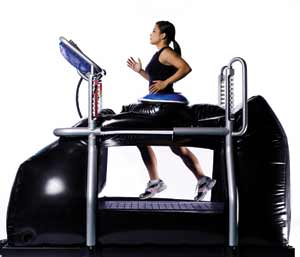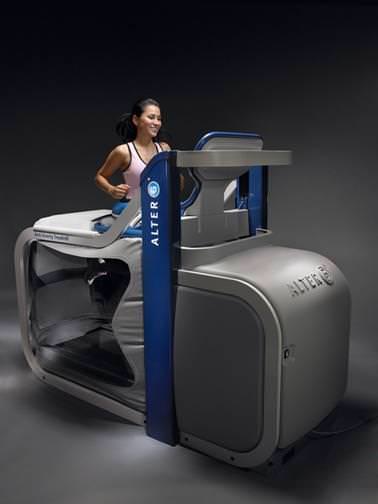Ever wonder what it would be like to walk on the Moon or run on Mars? A treadmill developed using NASA technology can provide users the feeling of moving about in less than 1 G. Anti Gravity treadmills, sold under the name of Alter-G, are becoming common in hospitals, rehab centers, and sports facilities, and just about every professional sports team in North America has one. They are a bit pricey for individuals to afford, but athletes and physical therapists say the device is a fantastic addition to their exercise repertoire.
Anti G treadmills allow people to improve mobility and health, recover from injury and surgery more effectively, overcome medical challenges that limit movement, and enhance physical performance. Runners and other athletes use the anti gravity treadmills to maintain their fitness level after a minor injury, without adding stress to their injury.
The Alter-G treadmill creates a seal around the user’s waist and then inflates to create a pressurized environment that can take away up to 80% of the user’s body weight, lessening the pounding to the joints.
The technology was first proposed for use on the space station to actually increase the amount of gravity felt by the body by using differential air pressure in space to mimic the Earth’s gravity to prevent bone loss and muscle deterioration.

Ames Research Center scientist, Robert Whalen, who came up with the idea said the anti-G trainer evolved directly from his original idea of how to add weight to an astronaut’s body during treadmill exercise in the low gravity of space. On Earth, it works just the opposite, giving users an astronaut-like experience.
A variety of patients—whether suffering from brain injury, neurological disorders, athletic injuries, or other stresses on the joints such as arthritis or morbid obesity—now use the NASA-derived technology in physical therapy.
In order for the G-Trainer to control air pressure effectively, users first have to don specially designed shorts which attach to a waist-level enclosure. After the person’s lower body is sealed in an enclosure – basically a big plastic bag around the treadmill, the system performs a calibration, adjusting to the person’s size and weight. Then running speed and incline can be chosen, along with what percent of weight should be removed. If a patient desires more unloading—more weightlessness—a button is simply pressed on a touch screen, and the air pressure increases, lifting the body, reducing strain, and further minimizing impact on the legs.
Prices run from USD $24,000 to $75,000 or leases for about $500 a month.
For more information:

